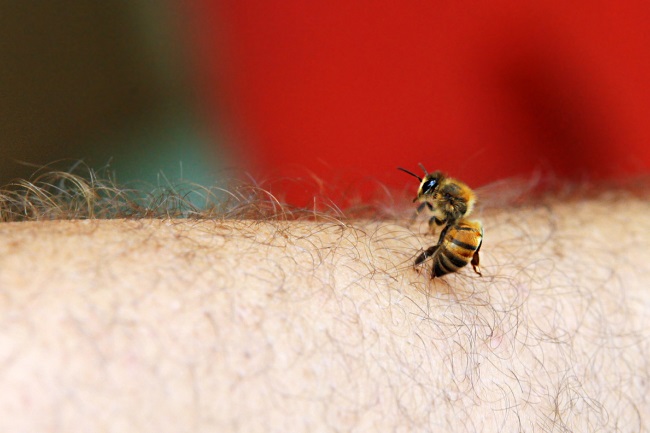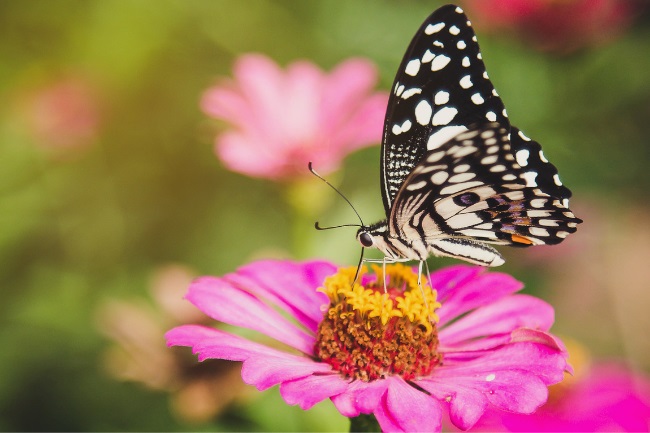Butterflies can’t sting as they do not possess a stinger. They also can’t bite, as they don’t have a mouth able of biting.
Contents
What is a stinger?

Stingers are usually defined as the part of an animal that administers a sting. In general, it is a hard or stiffened body part, often hollow and filled with venom.
The most famous stinger is of course that carried by many bee and wasp species. Attached to the end of their abdomen it is in fact an evolved ovipositor, a device females use for laying their eggs. This is the reason only female wasps and bees have one.
The stinger is hollow and connected to a venom chamber. As the bee or wasps stings its prey venom is released into their skin, causing an unpleasant reaction. Most stingers are straight and can be used multiple times, however, a honey bees stinger is barbed, meaning it becomes stuck in the skin. This causes the honey bees death as the stinger gets ripped out of their own bodies.
As well as the stingers carried by bees, other animals can have stings, such as scorpions, or even platypus. While the location and the morphology of the sting may be different, they all work in much the same way, by a sharpened appendage administering chemicals into the body of another animal.
Also read: Why do Bees Sting? What Happens After? (Explained)
Can butterflies sting?

A small number of caterpillars have the ability to sting. The unpleasant sensation is generally delivered, not by a stinger, like with a bee, but by irritating hairs. These hairs are hollow and often filled with venom. As they are touched they break, delivering the poison.
Very few caterpillars have this ability, with the majority being perfectly harmless. Their adult forms, however, don’t even possess this defence.
Butterflies lack any kind of irritating hairs, stingers, or even the ability to bite. Their long, tube-like proboscis, which they use for sucking up nectar, can to some people look like the biting mouthparts of a mosquito, but they aren’t designed for this kind of more morbid feeding.
Also read: What do Butterflies Eat and Drink? (Detailed Guide)
A simple strategy
Stingers are generally used in defence, though some animals may also use them to stun their prey so they can kill them. A butterfly’s only prey is nectar, so stings aren’t necessary for feeding, however, they might come in handy in self-defence.
Therefore, if butterflies don’t defend themselves with stings, how do they go about protecting themselves in this big bad world?Though they don’t administer toxins through a stinger, some butterflies do use a chemical defence in a very different way. Having built up poisons in their bodies from foods they ate as caterpillars they now use them to put predators off trying to eat them.
Poisonous butterflies are often brightly coloured to put off those that might fancy a bite. Bright reds, yellows or oranges, in particular, act as warning colours. If a hungry bird does pick up one of these little morsels they’ll soon find themselves spitting it back out. The next time they find themselves hungry they’ll be unlikely to give one of their unfortunate meal’s relatives a go.
As well as using toxins in their defence, many butterflies use camouflage to keep themselves off the radar. Some species, such as commas and peacock butterflies, have outer wings that resemble bark, meaning they simply disappear when they choose to.
| Defense Mechanism | Description |
|---|---|
| Camouflage | Butterflies use their wing patterns and colors to blend in with their surroundings, making it difficult for predators to spot them. |
| Toxic Chemicals | Some butterfly species contain toxins in their bodies that they acquire from the plants they feed on during their caterpillar stage. These toxins make them unpalatable or even toxic to predators. |
| Mimicry | Certain butterfly species mimic the appearance of toxic or unpalatable species, deterring potential predators from attacking them. |
| Flight Patterns | Butterflies have swift and erratic flight patterns that make them challenging for predators to catch. |
| Startle Displays | Some butterfly species have eye spots or sudden wing movements that startle predators, giving the butterfly an opportunity to escape. |
Also read: What do Caterpillars Eat? (Vegan vs. Carnivore Caterpillars)
Your friendly neighborhood butterfly
Lepidopterophobia is the name for the fear of butterflies (and moths), and it is surprisingly common. However, the good news is there really isn’t anything to be afraid of when it comes to their colourful, busy little insects.
Not only can a butterfly, not sting, and not bite, it isn’t even able to poison you unless you sit down to a banquet of butterfly wings.
Butterflies are generally interested in two things, feeding and mating. Apart from planting the odd flowers to help out our little pollinator friends, we really don’t have much to do with either of our butterflies’ life goals.
Essentially butterflies are too busy to worry about us worrying about them, but at least you now know there’s no such thing as a butterfly sting.

